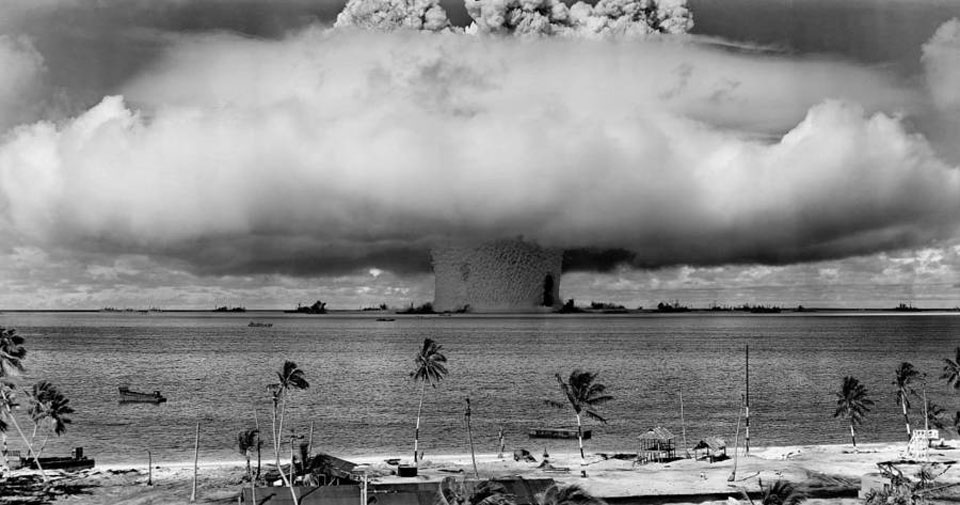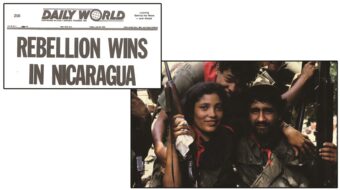
HIROSHIMA, Japan—Tick…tick…tick.
That’s the ominous sound of the Doomsday Clock today, the 75th anniversary of the U.S. bombing of Hiroshima, Japan on August 6, 1945. The gruesome timer is kept by the Bulletin of the Atomic Scientists.
Their clock is now at 100 seconds before midnight, the closest it’s been to worldwide atomic destruction since the height of the U.S.-Soviet Cold War in 1953, the Chicago-based bulletin says.
If it hits midnight, the world is at a nuclear Armageddon, the scientists forthrightly declare.
There are several reasons why the world is ever closer to that doom, say both the governor of Hiroshima prefecture (state) in Japan, Hidehiko Yuzaki, and Bulletin editor John Mecklin. Hiroshima is in the forefront, understandably, of the worldwide campaign to abolish the globe’s nuclear weapons.
No one knows how many people were killed in the two nuclear blasts at Hiroshima and Nagasaki, three days later. Estimates started at 125,000, quickly rose past 200,000, and have gone up from there, as survivors have died, but so have their children, from radiation-caused diseases.
But while the survivors and their allies in worldwide peace movements continue their campaigns, including in ceremonies this week in the U.S., Japan and elsewhere, world leaders have shunted them aside, the governor wrote.

“There are still more than 13,000 nuclear weapons in the world, with the nuclear weapon countries continuing to modernize their nuclear forces. Today, as nuclear disarmament continues to stagnate, the situation concerning the elimination of nuclear weapons is extremely bleak,” Yuzaki said on a special section of the Bulletin’s website.
That section, devoted to the Hiroshima and Nagasaki bombings by the U.S. Army Air Corps, and their aftermath, contains Yuzaki’s analysis and others. The U.S. remains the only country that ever used nuclear weapons against another nation. The analysis of that bombing is at https://thebulletin.org/collections/hiroshima-nagasaki/
“This is indicated by the U.S.-encouraged lapse of the Intermediate-Range Nuclear Forces (INF) Treaty, the United States’ unilateral withdrawal from the Iran nuclear deal, officially known as the Joint Comprehensive Plan of Action (JCPOA), Iran’s suspension of the fulfillment of some of the JCPOA requirements, and the issue of the extension of the New Strategic Arms Reduction Treaty (START), which is scheduled to expire next year,” the governor continues.
Deterrence, in the past euphemistically named “Mutually Assured Destruction,” won’t work, Yuzaki contends. Mecklin elaborates. The reason, he says, is that the ability to manufacture nuclear weapon components and bombs themselves has proliferated. And politicians don’t want to control it, the editor added, though he named no names.
“Continued corruption of the information ecosphere on which democracy and public decision making depend has heightened the nuclear and climate threats,” Mecklin wrote when the Bulletin moved the clock from two minutes to midnight to the current 100 seconds early this year.
“In the last year, many governments used cyber-enabled disinformation campaigns to sow distrust in institutions and among nations, undermining domestic and international efforts to foster peace and protect the planet.”
“This situation–two major threats to human civilization, amplified by sophisticated, technology-propelled propaganda–would be serious enough if leaders around the world were focused on managing the danger and reducing the risk of catastrophe. Instead, over the last two years, we have seen influential leaders denigrate and discard the most effective methods for addressing complex threats–international agreements with strong verification regimes–in favor of their own narrow interests and domestic political gain.”
“By undermining cooperative, science- and law-based approaches to managing the most urgent threats to humanity, these leaders have helped to create a situation that will, if unaddressed, lead to catastrophe, sooner rather than later.”
That leaves the citizen campaigners for nuclear disarmament with a steep hill to climb, even as they use the 75th anniversary of the two bombings to propel their cause.
The horrifying carnage and subsequent deaths and illnesses -Yuzaki says Hiroshima residents are still finding evidence of vaporized people beneath their streets – have led to a worldwide campaign by the survivors for the complete abolition of nuclear weapons.
Some historians, notably Gar Alperovitz in the Los Angeles Times, question whether dropping the bombs was necessary to defeat Japan in the closing days of World War II. He argues that President Truman dropped them more as a warning to the USSR that in the new post-war world the U.S. was supreme. And the USSR was developing nuclear bomb capability, too. It had been doing so since 1942.

At least one scientist who worked on the bomb, physicist Leo Szilard, came to that conclusion but by a different route. Szilard argued, correctly in retrospect, that dropping the bomb would set off a ruinous arms race, especially with the USSR, and avoiding that “might be more important than the short-term goal of knocking Japan out of the war,” historian David McCullough wrote in his biography, Truman.
But Szilard’s long detailed memo went to FDR, who died before he could read it. His aides deflected Szilard. Both Truman and his aides, in subsequent memoirs, described how the U.S. president obliquely told Stalin in 1945 about “a new weapon of great strength,” that the U.S. was developing.
The memoirs add that Stalin took Truman’s news, delivered at the postwar summit in Potsdam, Germany, stolidly, though he then ordered Soviet scientists to speed up A-bomb development work.
Stalin also agreed to continue the Soviet Union’s fight against Japan which it had been carrying out in China, despite the burden of its struggle against the Nazis in Europe, by joining the fight in the Pacific.
Alperovitz contends the Japanese were most afraid of this Soviet expansion of the war effort against them, and that it would have led them to surrender, anyway. The bombs were dropped against the cities while Truman was on board an aircraft carrier on his way back to D.C., from Potsdam.
That leaves the citizen campaigners against the bombs, not just from Hiroshima and Nagasaki, but from the U.S., where millions of people lived downwind from atomic testing sites, such as residents of St. George, Utah, who were downwind from the Nevada test site, or who worked with atomic materials, such as nuclear workers in Hanford, Wash., and Oak Ridge, Tenn.
Most were members of the old Oil, Chemical and Atomic Workers, now part of the Steelworkers. They and their survivors now are recipients of a special federal aid program to cover their medical bills.
And Hanford and Oak Ridge are just two of the hundreds of sites where people—nuclear workers and innocent civilians—have been exposed to atomic radiation in the years since the bombs were dropped.

The Hiroshima/Nagasaki Peace Committee of the National Capital Area, which sponsored a speech last year by a Nagasaki survivor, keeps a database of nuclear radiation sources nationwide that expose people to the danger. The committee is hosting a series of pro-peace events from August 6-9 in the D.C.-Baltimore area, despite the coronavirus pandemic’s ban on indoor gatherings of more than 10 people.
The nuclear danger the citizen campaigners warn about is not just at military bases. It’s at nuclear power plants, hospitals, reactors, storage sites, dumpsites, laboratories, and former weapons and plutonium development sites, such as Hanford, Oak Ridge and Paducah, Ky., among others.
Illinois has 109 such sites alone, ranging from nine at Argonne National Laboratories in Batavia to nine nuclear reactors at Braidwood, Bryon, Dresden, and Seneca, combined.
One is the site of the first sustained nuclear reaction in 1942, supposedly “cleaned up” in 1993. That reactor site now is alongside the University of Chicago’s main library. It’s marked by a monumental bronze Henry Moore sculpture, warning of the dangers of the bomb.
Moore sculpted a skull, shaped like a mushroom cloud.
Like free stuff? So do we. Here at People’s World, we believe strongly in the mission of keeping the labor and democratic movements informed so they are prepared for the struggle. But we need your help. While our content is free for readers (something we are proud of) it takes money — a lot of it — to produce and cover the stories you see in our pages. Only you, our readers and supporters, can keep us going. Only you can make sure we keep the news that matters free of paywalls and advertisements. If you enjoy reading People’s World and the stories we bring you, support our work by becoming a $5 monthly sustainer today.












Comments